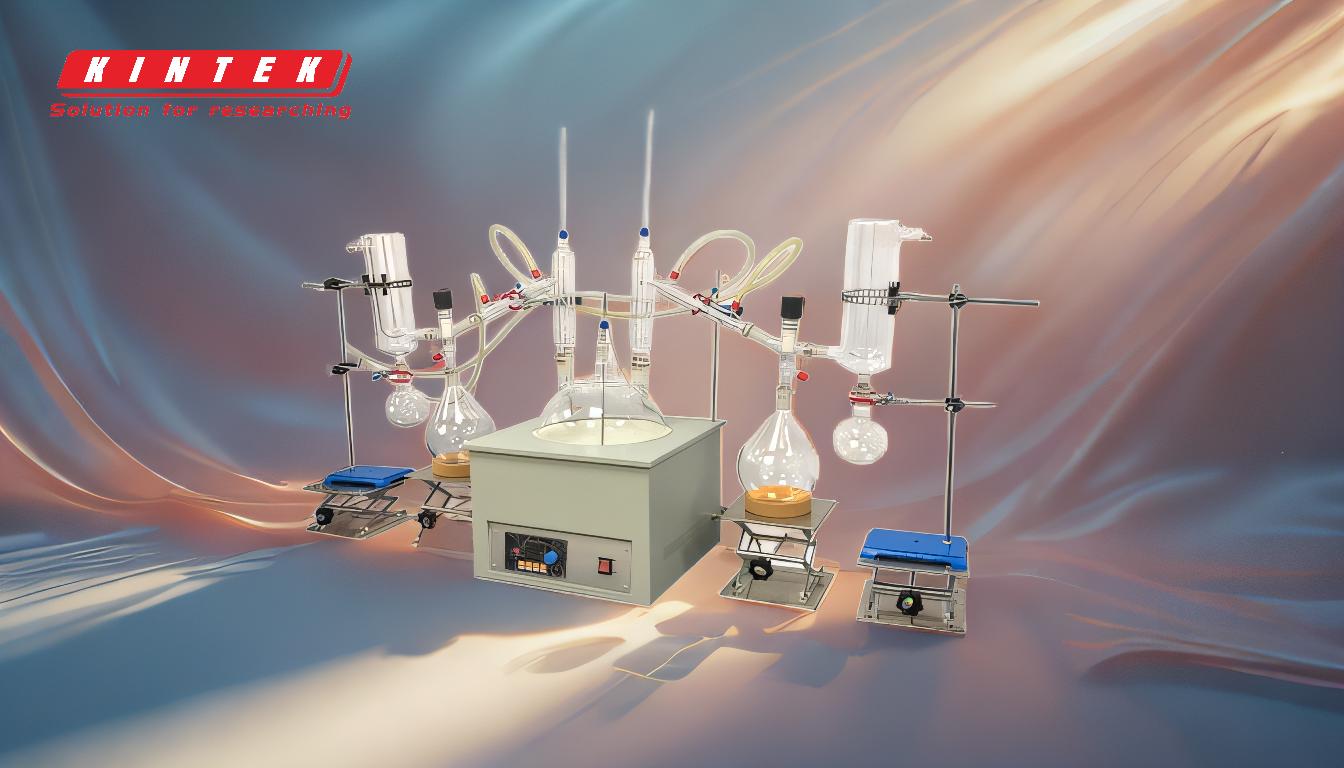Short-path distillation is a specialized technique used to separate and purify heat-sensitive or high-boiling-point materials by exploiting differences in their volatilities under reduced pressure. The process involves heating a mixture to vaporize its components, which then travel a short distance to a condenser where they are cooled and collected as liquids. This method is particularly effective for compounds that degrade at high temperatures, as it allows for lower boiling temperatures due to the reduced pressure environment. The equipment used, known as a short-path distillation unit, is designed to operate under very low pressures (as low as 0.001mbar) and includes features like an internal condenser opposite the heating surface to ensure efficient separation.
Key Points Explained:

-
Principle of Short-Path Distillation:
- Short-path distillation relies on the differences in boiling points of components in a mixture. By heating the mixture under reduced pressure, components with lower boiling points vaporize first, while those with higher boiling points remain in the liquid phase.
- The vaporized components travel a short distance (often just a few centimeters) to a condenser, where they are cooled and condensed back into a liquid. This short travel distance minimizes the risk of thermal degradation, making it ideal for heat-sensitive materials.
-
Equipment and Setup:
- A short-path distillation unit typically consists of a boiling flask, a heating source, a magnetic stirrer, a condenser, and a collection flask.
- The boiling flask holds the mixture to be distilled. A magnetic stirrer ensures uniform heating and prevents localized overheating.
- The condenser is placed close to the boiling flask to minimize the distance the vapor must travel. It is cooled by water or another cooling medium to condense the vapors into liquids.
- The system operates under a vacuum, which lowers the boiling points of the components, allowing for separation at lower temperatures.
-
Operating Conditions:
- Short-path distillation is performed under reduced pressure, typically below 1mbar, and can go as low as 0.001mbar. This low pressure is crucial for reducing the boiling points of the components and preventing thermal degradation.
- The temperature of the heating source must be carefully controlled to ensure that only the desired components vaporize. Overheating can lead to decomposition of sensitive compounds.
-
Applications:
- This technique is widely used in the purification of heat-sensitive materials, such as essential oils, pharmaceuticals, and high-boiling-point organic compounds.
- It is also employed in the separation of complex mixtures, such as crude oil, where fractional distillation is required to isolate specific components.
-
Advantages:
- Low Temperature Operation: The reduced pressure allows for distillation at lower temperatures, preserving the integrity of heat-sensitive compounds.
- High Purity: The short travel distance and efficient condensation result in high-purity distillates.
- Versatility: Suitable for a wide range of materials, including those with high boiling points or those that are unstable at high temperatures.
-
Limitations:
- Scale Limitations: Short-path distillation is typically used for small-scale operations due to the complexity and cost of maintaining high vacuum conditions.
- Equipment Cost: The specialized equipment required for short-path distillation can be expensive, making it less accessible for some applications.
- Maintenance: The system requires regular maintenance to ensure the vacuum is maintained and the condenser functions effectively.
-
Step-by-Step Process:
- Step 1: Preparation: The mixture to be distilled is placed in the boiling flask. The system is sealed, and a vacuum is applied to reduce the pressure.
- Step 2: Heating: The mixture is heated gradually, with the temperature controlled to ensure only the desired components vaporize.
- Step 3: Vaporization: The vaporized components rise from the boiling flask and travel a short distance to the condenser.
- Step 4: Condensation: The vapors are cooled in the condenser, where they condense back into a liquid.
- Step 5: Collection: The condensed liquid is collected in a separate flask, while any remaining components continue to be heated and distilled.
-
Safety Considerations:
- Vacuum Handling: Operating under high vacuum requires careful handling to prevent implosion or leaks.
- Temperature Control: Precise temperature control is necessary to avoid overheating and potential decomposition of sensitive materials.
- Cooling System: The condenser must be adequately cooled to ensure efficient condensation of the vapors.
In summary, short-path distillation is a highly effective method for separating and purifying heat-sensitive or high-boiling-point materials. By operating under reduced pressure and minimizing the distance the vapor must travel, it allows for lower temperature distillation, preserving the integrity of the compounds being processed. While it has some limitations, such as scale and cost, its advantages in terms of purity and versatility make it a valuable technique in various industries.
Summary Table:
| Aspect | Details |
|---|---|
| Principle | Separates components based on boiling points under reduced pressure. |
| Equipment | Boiling flask, heating source, magnetic stirrer, condenser, collection flask. |
| Operating Pressure | Below 1mbar, as low as 0.001mbar. |
| Applications | Essential oils, pharmaceuticals, high-boiling-point organic compounds. |
| Advantages | Low-temperature operation, high purity, versatility. |
| Limitations | Small-scale operations, high equipment cost, regular maintenance required. |
Discover how short-path distillation can optimize your material purification process—contact us today for expert guidance!










